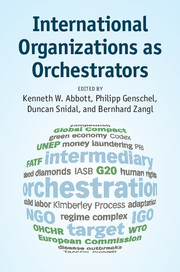Book contents
- Frontmatter
- Contents
- List of Figures
- List of Tables
- List of Contributors
- Acknowledgments
- List of Abbreviations
- Part I Introduction
- Part II Managing states
- 2 Orchestrating policy implementation
- 3 Orchestration on a tight leash
- 4 Orchestration by design
- 5 Efficient orchestration?
- 6 Orchestrating monitoring
- 7 Orchestrating enforcement
- Part III Bypassing states
- Part IV Implications
- References
- Index
5 - Efficient orchestration?
The Global Environment Facility in the governance of climate adaptation
Published online by Cambridge University Press: 05 April 2015
- Frontmatter
- Contents
- List of Figures
- List of Tables
- List of Contributors
- Acknowledgments
- List of Abbreviations
- Part I Introduction
- Part II Managing states
- 2 Orchestrating policy implementation
- 3 Orchestration on a tight leash
- 4 Orchestration by design
- 5 Efficient orchestration?
- 6 Orchestrating monitoring
- 7 Orchestrating enforcement
- Part III Bypassing states
- Part IV Implications
- References
- Index
Summary
Abstract
Financing for climate adaptation is governed by an unusual arrangement whereby the GEF channels funds through other IGOs – including the World Bank, UNEP and UNDP – which in turn develop and implement projects on the ground. The concept and techniques of orchestration outlined by the framework authors help us understand this complicated governance arrangement. The GEF, as orchestrator, supports and steers various intermediaries (the “implementing agencies”) to effect change in target states (developing-country recipients). In our explanation of this outcome, we find support for four of the volume’s hypotheses: intermediary availability, orchestrator focality, goal divergence and state oversight. We also explore whether the relationship between the GEF and its implementing agencies is efficient and complementary. We find that this is generally the case and that the orchestrator capabilities and intermediary availability hypotheses capture this arrangement quite well. While the climate adaptation case offers considerable support for the theoretical framework, recent developments raise concerns about the robustness of orchestration as a governance equilibrium, which may evolve over time toward harder and direct modes of governance.
Introduction
International relations (IR) scholars have devoted considerable attention to explaining the design and functions of IGOs. Most existing work, theoretical and empirical, has focused on individual institutions as the unit of analysis (Hawkins et al. 2006; Koremenos, Lipson and Snidal 2004), yet many issue areas are governed by multiple IGOs with overlapping mandates and complicated relationships (Alter and Meunier 2009; Biermann et al. 2009; Gehring and Oberthür 2008).
- Type
- Chapter
- Information
- International Organizations as Orchestrators , pp. 114 - 138Publisher: Cambridge University PressPrint publication year: 2015
- 10
- Cited by



